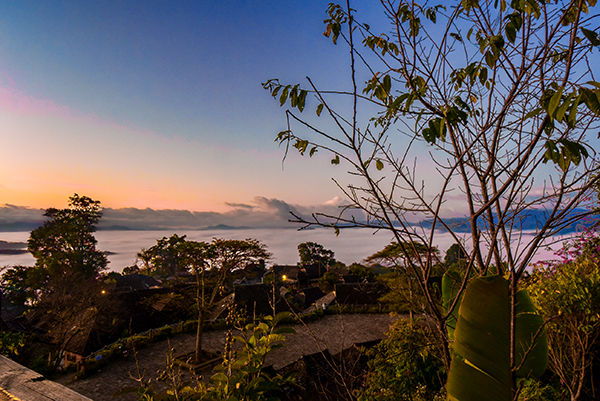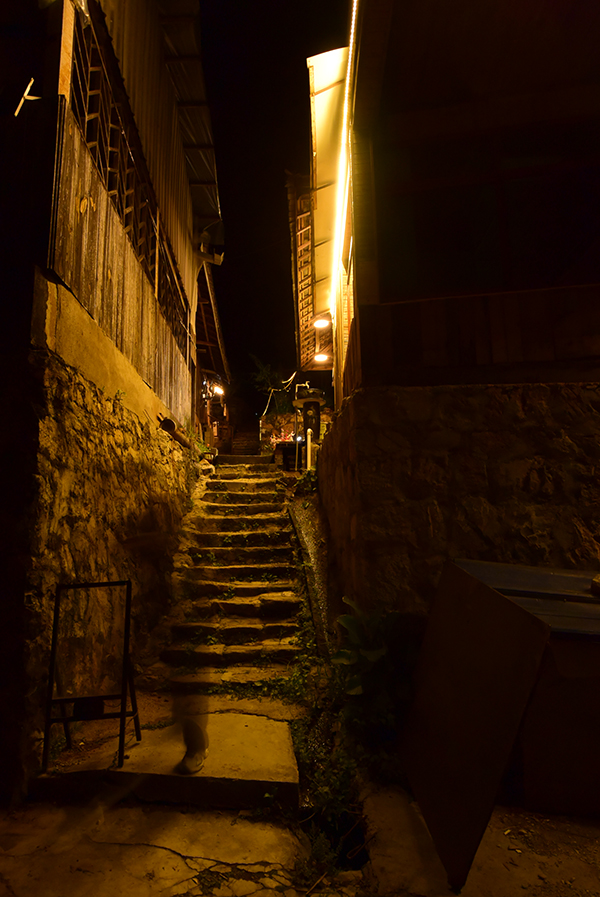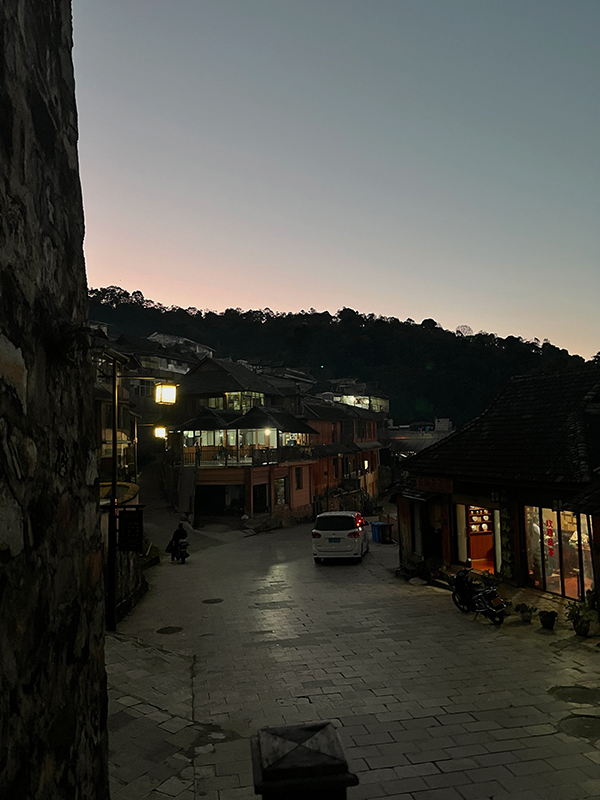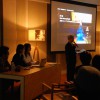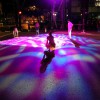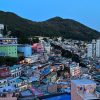Nightscape in Jingmai Mountain
2023.12.08 – 12.13 Kyoko Takubo + Hongna Chen
Located on the southwest border of China, Jingmai Mountain is the birthplace of Pu’er tea, where the indigenous people have created an ancient tea forest cultural landscape, which was registered as a UNESCO World Heritage Site in September 2023.
While working on the project, we became interested in the local culture. So we decided to survey the villages at night and to observe and report the impact of tourism development on the local nightscape.

■Introduction
Visiting Jingmai Mountain isn’t easy. First, spend the night in Kunming, then leave early morning for the destination by plane or train.
We had planned to fly from Langcang Jingmai airport, but our flight was suddenly cancelled. So we had to travel to Pu’er by train and grab a cab to Jingmai Mountain.
During our stay, we were based in Huimin Town where our project TEA CELLAR is located. We visited Nuogang Village, Wengji Village, and Jingmai Village to observe the people’s daily life and the nightscape there.

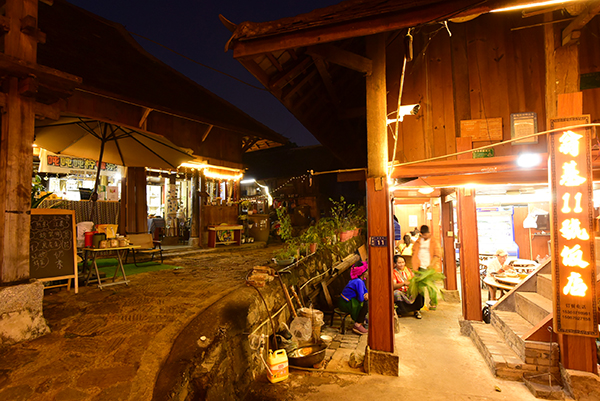
■ Nuogang Village
Nuogang Village is a historic village of the Dai tribe, where the villagers have maintained their traditional lifestyle. The first floor of the house, with its distinctive gabled roof, is used for tea production and for the teahouse. The second floor with a tiled roof is a living space.
The owner of the teahouse told us that the first floor is open to guests and the family lives on the second floor. We found it interesting that the boundary between private and public life is blurred here.
We only saw the local lives during the day, but at night, when everyone moves upstairs, the lights go out, and we believe that the whole village goes to sleep in the dark.

and a living space on the second floor

■ Wengji Village
Wengji Village is a village of the Blang tribe located near the mountain top and is famous for the sea of clouds. We stayed there for a night.
Unlike the historic atmosphere of the day, they all turn on the LED lights at dinner time to catch tourists’ attention. Lightstrips were exposed and hung haphazardly, too bright for the historical and cultural landscape. Battles of LED lights were being waged to outdo each other where restaurants were clustered. Feeling uncomfortable with this scene at first, as hours passed, we found the spilled light of the stores guiding visitors. In a small plaza, it creates a pool of light for people to gather.
The macadam alleys were illuminated with beautiful gradations of light. Lightstrips played a heroic role on the steep stairs with poor footing. The village’s gently sloping terrain makes the landscape even richer.
The contrast between the roof silhouettes, the blue moment sky, and the warmly illuminated stone walls and macadam floors were so charming and beautiful. We could not stop strolling along the alleys weaved between the houses, until the sky was dark.
After 9pm, more stores closed their doors and turned off their lights. The village gradually became darker. The security lights on the roof, which we didn’t notice during the day, gives us the minimum illuminance to walk down the alley.
It was impressive to see how the local people had created the nightscape of the neighborhood using their ingenuity to illuminate their houses and to welcome guests, changing the brightness and the settings according to the purpose. We believe that less glare and more effective lighting fixtures would enhance the best of the local culture. (Kyoko Takubo)
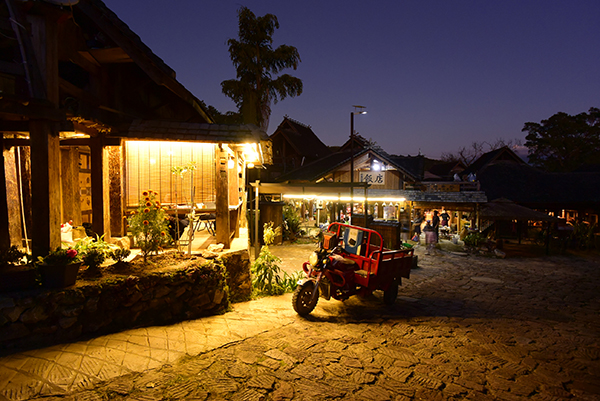
■ Jingmai Village


Jingmai Village is the tea transportation hub in Jingmai mountain where Dai tribe is nestled. At night, Jingmai Village is especially quiet as its residents still follow the traditional rural routine; working at sunrise and returning at sunset. Therefore, the night at the village mainly rely on the spilled interior light and pole lights.
Sketch 1 shows the street lighting observed from the second floor of a tea shop. As most of the pole lights are not working, the light to the street mainly comes from houses, and the color temperature and the illuminance are inconsistent.
The dim lighting environment was not deliberately planned, but consists mainly of interior lighting in the houses, which gives a sense of the daily activities of the villagers. We found almost no people walking around the village at night. That may be one of the reasons that most of the pole lights are not operated.
It would be nice to add small solar spotlights on the roof, to highlight the ox horn shape, the unique architectural style of the Dai people.
Sketch 2 shows the lighting effect of the pole light on the street. The pole light is in a lantern shape with a solar panel, nicely match to the surrounding. There is only 5lux under the light and 2lux at the centre of the road. We felt it dim but it is adequate in the isolated village.
There are different kinds of pole lights in Jingmai Village, but not all the fixtures are turn on at night. Those pole lights should be properly maintained, as there are safety issues and unnecessary glare issues caused by cars.
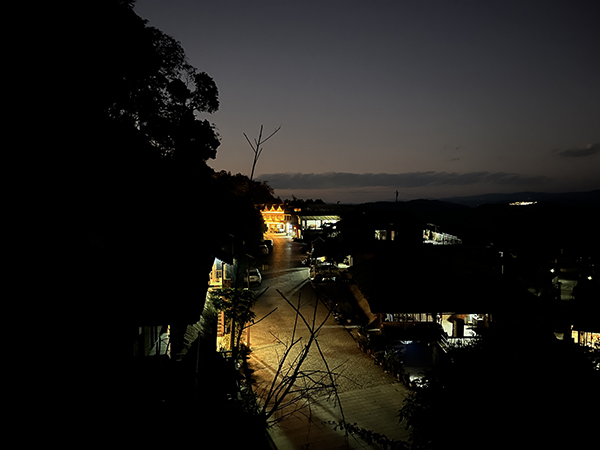
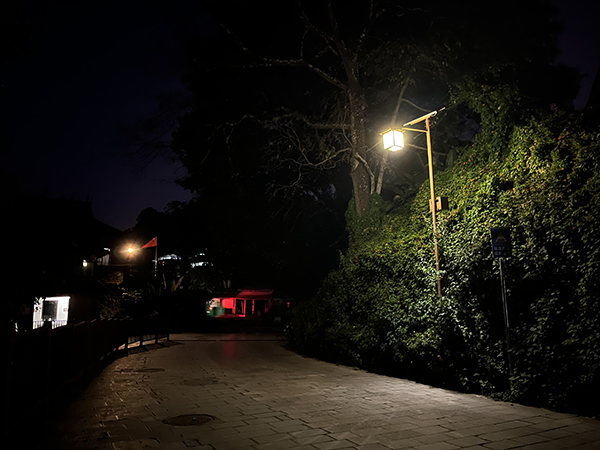



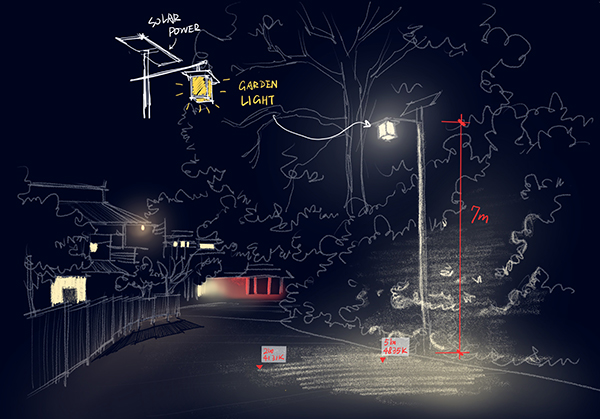
■ Huimin Town
Located at the entrance of Jingmai Mountain, there are various facilities such as car parks, stores, restaurants and tourist service centres. Since a heavy traffic highway runs though Huimin town, the main street lighting consists of the pole lights, store lightings and some trees with decorative lightstripes. The whole lighting effect is very chaotic as shown on the sketch 3.
In this survey, we found two main issues:
- The street lights are on timer but not linked to the season. None of the street lights were turned on until 20:00, while the sunset was around 19:00. So we had to stay in the dark environment for an hour. Perhaps the government was trying to save the energy as these street lights are not solar powered.
- There were two different pole lights in different color temperatures, 6000K and 2600K. As the gateway to Jingmai Mountain, we felt the warm tone of 2600K lights are suitable for this town.
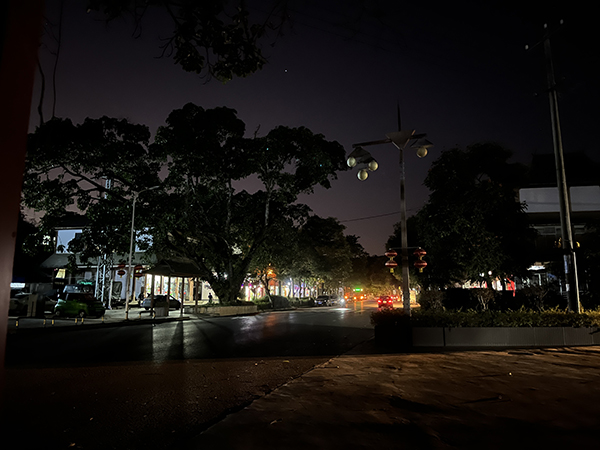

6000K at left, 2700K at right
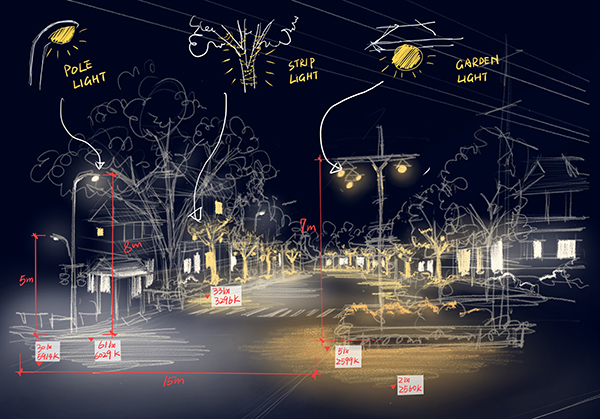
Store lightings have a big impact on the entire street. Some store owners have added many lamps inside and outside to attract visitors’ attention, and that results in glare issues.
We also observed the wide sidewalks which is about 5-6m widths. Because of the width, the pole lights alone were not bright enough for the pedestrians. We assume that is the reason that there are extra luminaires added to give more illuminance to the sidewalk. Therefore, the lighting environment in Huimin Town looked unorganized, as the result of adding lights to wherever necessary without a overall planning as a town. (Hongna Chen)
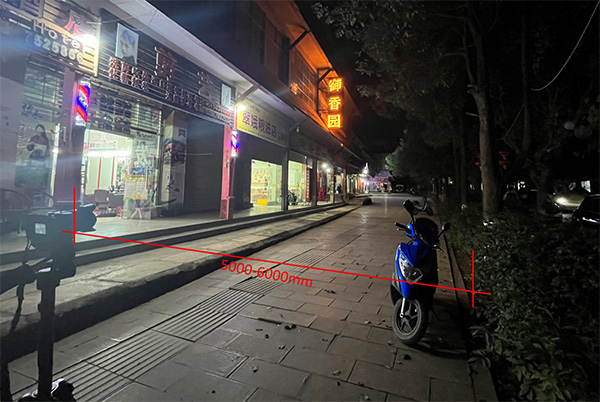

■Summary
Each village in Jingmai mountain has its own unique characteristics. We clearly felt they have successfully adopted LED lighting and made the best use of it in their daily lives, inheriting the historical tea culture and the customs. Observing the way they coexist with nature with minimal lighting in their houses gave us a good opportunity to re-think about our modern lifestyle.
Undergoing its rapid development and growth, Huimin Town seems having hard time to catch up with the changes. As Huimin Town will be welcoming more tourists in the future, the top priority is to preserve the culture of Jingmai Mountain and to well-organize the lighting environment.
On the way home in early morning, we managed to see the sea of clouds covering the tea fields. It was a fantastic scenery that the lights, must be around 4000K, creating white dotted glows in dark tea fields. (Kyoko Takubo)
